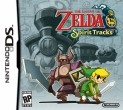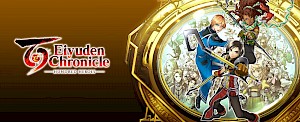Review: The Legend of Zelda: Spriit Tracks
Posted 07 Mar 2010 at 14:41 by Sam Gittins
DS Review

| "What we have here is still a stunning technical achievement in its own right." |
When the first Zelda game was released on the DS some time ago in the form of Phantom Hourglass it was nothing short of impressive in terms of what Nintendo had achieved - a top-down and yet three-dimensional game in the series which we hadn't thought possible until then. Using one of the console's greatest strengths - that of the Cel-Shading technique - the world that had been created was both believable and easy to get immersed in, although there were a few gameplay choices which diluted the great adventuring aspect the Zelda series is renowned for.
This time around it's more of the same in some respects as you begin the game as an apprentice Train Operator – yes Hyrule has its own railway now – you are due to attend a ceremony where you are certified by none other than Princess Zelda herself - but of course something goes wrong and you end up having the spirit of Zelda assist you during the game.
As the title suggests you will be traversing much terrain by train along specifically laid out tracks; while this alleviates a problem from the previous game (the meandering sailing sections) it brings about another which is that of linearity. The train itself is pretty simple to control via the touch screen but when you're automatically being taken to your chosen destination it simultaneously destroys some of the adventure. That's not to say that traveling by train is less than stellar, it's actually fantastical when done in typical Nintendo fashion, it's just that it seems however a three-dimensional Zelda game is implemented on the DS we are always going to be limited on the overworld. This is probably due to hardware limitations so we will no doubt have to wait for the DS2 until we get to explore in-between dungeons 'properly' once more.
Back to the present day however, what we have here is still a stunning technical achievement in its own right; everything moves fluidly and looks even better than before, there are more parts where the view extends to both screens, such as in some fantastic boss battles. The visuals consistently shine - especially in places such as the tower which is the game's new 'hub' of sorts. You complete the tower in parts after each dungeon which feels a lot more manageable than Phantom Hourglass' infamously infuriating Temple.
While in dungeons you will encounter the Phantoms from Link's first outing once again, however this time they don't seem as threatening as they once were, thankfully owing to a new game mechanic which sees the spirit of Zelda being able to possess the bodies of phantoms and allow you to control both her and Link alternately to advance, which is a refreshing change. Of course you still get to pick up new items such as a hand-held windmill that you must blow into the DS' microphone slot to use which works rather well indeed.

Not only will you be blowing into the microphone for just that one purpose though, for there is another major item in the game produced in similar vein to the infamous ocarina which requires use of both the touch screen and the microphone. That item is a set of Spirit Pipes, which will aid you a great deal throughout the game. They are simple to use as you slide the stylus to align which note you wish to play and then blow to produce sound; it's a wonderful addition which even goes some way to recapturing the magic of playing the ocarina, especially when learning major new songs.
There is of course more than just the main quest with the addition of mini-games to play and various things to collect during your travels, (including rabbits!) which you can capture once your train is equipped with a cannon (not for the rabbits) and when you possess the catching net. Other additions include a postal lottery where you can win a certain amount of items each day by sending postcards – on a side-note the new postman character is rather amusing, yet another example of a character that only Nintendo would come up with – which makes things a little more interesting and will aid you in completing your treasure collection.
Playing with multiple players in the Battle Mode is still possible in the game albeit this time with no online support, though to be fair it was only ever seen as an accompaniment to the main adventure. It's still playable in local wireless mode and even allows for download play but it's essentially more of what was in Phantom Hourglass, so if you've played it before then you know what to expect and if you haven't then it'd be advisable to give it a try at some point but know it's nothing more than an amusing distraction.
Everything else about the game seems to follow the tried and tested methods of its predecessor from the almost entirely stylus controlled action to the writing on the map to solve more intricate puzzles or simply note down reminders. Zelda veterans will no doubt notice similarities and patterns during parts of the game such as the infamous multi-switch hitting boomerang puzzles, which while fresh in Wind Waker feel somewhat stale by today's standards.
Repetition of past ideas aside however this is still yet another magical Zelda adventure which fans won't want to miss out on; plenty of new elements have been brought to the table which was so lavishly laden with treats in Phantom Hourglass, some of them may be a little stale now but the new morsels make it palatable and enjoyable once again. Welcome back Link, we've missed you.
N-Europe Final Verdict
Another excellent portable Zelda title in almost every respect; Spirit Tracks will keep you entertained for a good while just don't expect huge leaps and bounds in terms of innovation. A marked improvement over its predecessor despite its faults.
- Gameplay4
- Playability4
- Visuals5
- Audio5
- Lifespan4
Final Score
9
Pros
Impressive visuals
Sublime sound
Excellent gameplay
Plenty to see and do
Cons
Some stale elements
Overworld linearity























